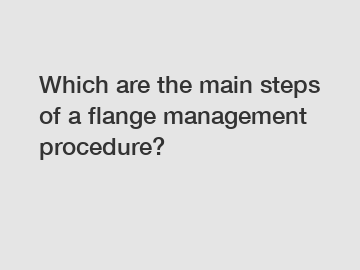Which are the main steps of a flange management procedure?
The main steps of a flange management procedure include identifying the flanges, conducting a visual inspection, cleaning and preparing the flanges, applying the gasket, bolting the flanges, and conducting a final inspection. These steps are crucial in ensuring the proper assembly and functioning of flange connections in industrial operations.
Firstly, the process begins with the identification of the flanges involved in the operation. This step is necessary as flanges come in different sizes, types, and pressure ratings, which need to be matched with the accompanying pipeline or equipment. By identifying the correct flanges, it minimizes the risk of mismatched connections and potential leakages.
Following that, a visual inspection is conducted to check for any damages, deformities, or corrosion on the flange surfaces. Any defects found could compromise the integrity of the connection, leading to leakages or failures. In such cases, corrective actions such as repairs or replacement may be necessary to ensure a secure and reliable flange connection.

After the inspection, the flanges must be cleaned and properly prepared. Cleaning involves the removal of rust, dirt, grease, or any other contaminants that could affect the performance of the flange connection. A clean surface is vital for achieving an effective seal between the flanges and the gasket.
Once the flanges are clean, a gasket is applied between them. The gasket helps to create a seal and prevent leakage in the connection. Depending on the specific requirements of the operation, different types of gaskets, such as spiral wound, ring joint, or rubber gaskets, may be used. It is crucial to select the appropriate gasket material and ensure it is installed correctly to achieve a reliable and leak-free connection.
The subsequent step involves bolting the flanges together. Proper bolting procedures, including the torque values and sequence, must be followed to ensure uniform distribution of the load on the gasket and prevent flange distortion. Insufficient or uneven bolt tightening can result in leakages or flange separation, compromising the safety and efficiency of the connection.
Lastly, a final inspection is conducted to verify the correct assembly and integrity of the flange connection. This inspection includes checking for proper alignment, gasket compression, and overall tightness. It is important to ensure that all steps of the flange management procedure have been followed accurately to minimize the risk of premature failure or unforeseen issues in operation.
The importance of following a flange management procedure cannot be overstated. Properly assembled and maintained flange connections are crucial for the safe and efficient functioning of pipelines, equipment, and various industrial operations. These procedures help to prevent leakages, reduce downtime, and ensure the integrity of the connections, ultimately contributing to overall operational reliability and safety.
In conclusion, the main steps of a flange management procedure involve identifying the flanges, conducting a visual inspection, cleaning and preparing the flanges, applying the gasket, bolting the flanges, and conducting a final inspection. These steps are essential for ensuring secure and reliable flange connections, minimizing the risk of leakages, and promoting the overall safety and efficiency of industrial operations.
If you are looking for more details, kindly visit Retro Jetting, Oil Flushing System, Electric Heat Tracing Design.


